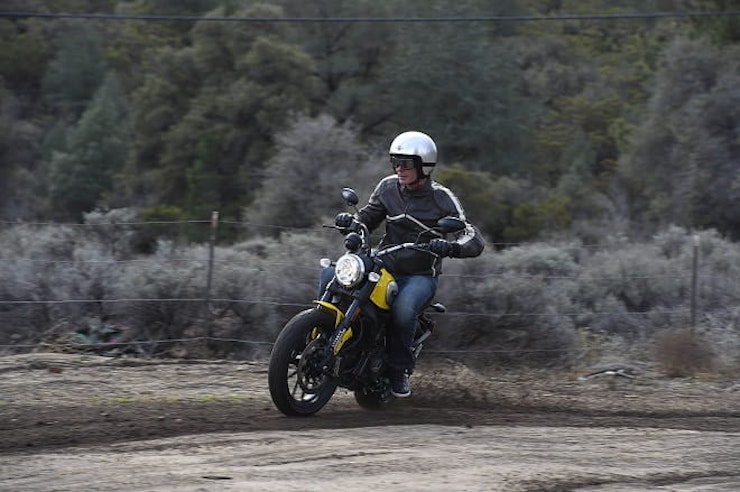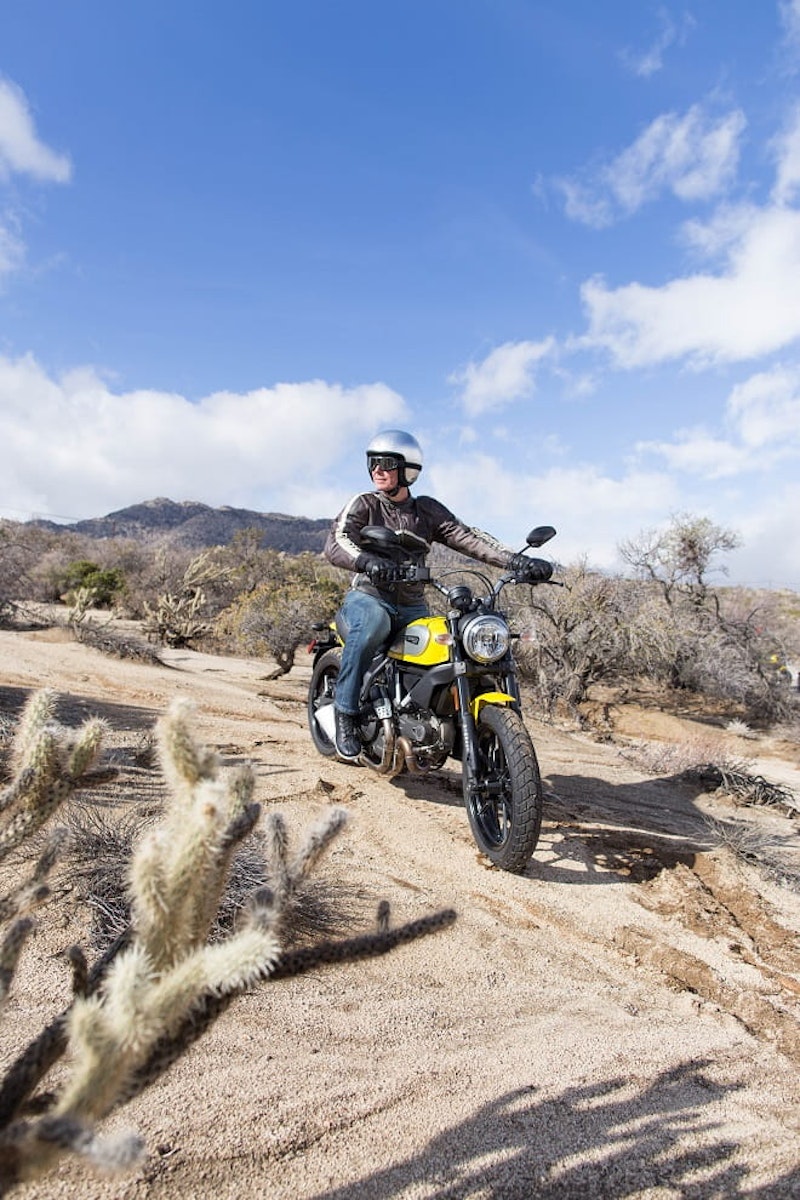Author: Roland Brown, pictures by Milagro Posted: 18 Dec 2014
If ever a bike has had a lot of hype to live up to, it's the Ducati Scrambler. The Bologna factory publicity machine has been running at full speed since the retro styled, entry level V-twin was unveiled in September. Ducati had even set up a 'Land of Joy' at the launch base hotel in Palm Springs, California, to showcase the four Scrambler models and 60-odd accessories and pieces of apparel.
So it says a lot about the Scrambler that a quick blat down a twisty road in the nearby San Bernadino Park aboard the base-model Scrambler Icon was enough to confirm that it's quick, easy to ride, sweet-handling, well braked and great to ride. So good, in fact, and even in many respects so Ducati-like, that all the marketing hype suddenly seemed redundant.
The official line is that this bike is a Scrambler, not a Ducati, but its basics are a variation on the firm's familiar theme. The motor is essentially the 803cc, aircooled sohc desmo V-twin from the Monster 796, detuned from 87 to 75bhp, primarily with new camshafts, intake and exhaust systems.
The tubular steel frame is new, and cycle parts are pretty basic: Kayaba forks and diagonally mounted shock working directly on the aluminium swing-arm; and a single brake disc at each end, the front one a big 330mm rotor gripped by a four-pot radial caliper from Brembo. Wheel diameters are 18-inch front and 17 rear, in the Icon's case cast aluminium, like those of the sporty Full Throttle, rather than wire-spoked as worn by the retro-themed Classic or dirtbike-styled Urban Enduro.
When you reach up to the wide, one-piece bar and press the button, the engine fires up with a typical aircooled Ducati sound from the stubby silencer by your right boot. This bike's not as loud as some Monsters but still has a definite V-twin noise and feel. And the Scrambler feels slightly Monster-like as it accelerates smoothly away, though it was quickly clear that this motor is tuned for low-rev grunt rather than storming top-end horsepower.
That's how it should be on a bike like this, and the Scrambler's easy power delivery made it pleasant to ride as we headed through Palm Springs's urban sprawl. There are no alternative modes to worry about, or any traction control. In the lower gears, especially, it could feel very slightly jerky if you tweaked the throttle, but generally I thought the response crisp and controllable. I also didn't have any issues with the six-speed gearbox, but a few riders reported stiff changes and false neutrals.
There's a fair bit of performance at the end of the wire, too, though the gentle delivery means that, for example, cracking the throttle open in first gear results in an enjoyably brisk rate of acceleration, but not in the front wheel coming far off the ground. The torque curve is so broad that the Scrambler always seemed to be in the right gear and to have a useful burst of acceleration in hand when required.
Once out of the city and onto a clear road the Ducati showed it could quickly put 100mph on the speedo, heading for a likely top speed of about 130mph. And more importantly it was happy to cruise smoothly at 70mph or more, the upright riding position adding to the sense of speed but meaning that's about as fast as most riders are likely to want to go for very long.
If the engine performance was impressive and just about right for the job, then the chassis was every bit as impressive. Stability in a straight line was not an issue, and when we reached some sweeping curves in the hills south of Palm Springs, the Scrambler was totally at home. Its wide handlebar gave plenty of leverage, combining with fairly sporty geometry and reasonably light weight (186kg wet) to make the bike entertainingly easy to flick from side to side.
Suspension was well up to the job too, despite the Kayaba units being relatively basic, with shock preload the only adjustability at either end. Spring rates are reasonably firm; enough to make the forks feel slightly harsh on one particularly bumpy, tarmac-cracked stretch of road. But I thought the rates at both ends were just about right: compliant enough to be reasonably comfortable, and also sufficiently firm and well damped to give good feedback and make the bike balanced and controllable.
Other bits worked well, too, notably that big front disc, which was adequately powerful and well backed-up by the smaller rear disc and the ABS system. The specially developed Pirelli MT60 RS tyres gave no trouble on either dry or damp roads; ground clearance was adequate if not exceptional.
MORE ON THE DUCATI SCRAMBLER!
Ducati Scrambler spied!
What's that on the new Ducati Scrambler?
Same goes for the comfort, practicality and finish levels. The seat's quite slim but seemed comfortable enough, and has a broader area for the pillion, though there's nothing solid to hold. The Scrambler also scores points for its handy USB socket and phone pocket under the seat. Fuel capacity of 13.5 litres isn't particularly generous, and at a likely average of 40mph means a realistic range of just over 100 miles.
Finish generally seemed pretty good, with neat touches such as the headlight's alloy surround and the removable tank sidepanels offset by a few rough details including the discoloured exhaust downpipes with their ugly lambda probe. The round, alloy-rimmed instrument panel looks good though it's a shame there's no fuel gauge or gear indicator.
But the Scrambler's overall look is great, the four models mean there should be one to suit most tastes, and there's plenty of potential for customisation. Better still, the Scrambler is keenly priced, with this yellow Icon costing £6995, the red version £100 less, and the other three models going for £7995. The Icon, in particular, looks like good value for a simple but stylish and fun-to-ride bike that succeeds in living up to the hype.
DUCATI SCRAMBLER ICON TECHNICAL SPECIFICATION
Ducati Scrambler Icon technical features at a glance
Steel teardrop-shaped tank with interchangeable aluminium side panels
Low seat (790 mm) for perfect stationary manoeuvrability
Low weight (170 kg dry) and low centre of gravity
Wide handlebars for a relaxed riding position
Headlight with glass parabola and ultra-modern LED light guide
Rear light with suffused-light LED technology
LCD instruments
L-twin air-cooled 803 cc engine
Machine-finished aluminium belt covers
Twin spar steel Trellis frame
Die-cast aluminium rear swingarm
10-spoke alloy wheels, 18" front, 17" rear
Enduro-derived Pirelli tyres optimised for the Ducati Scrambler
Dual-channel ABS as standard
Under-seat storage compartment with USB socket
Share on social media:

